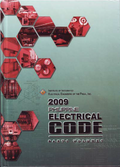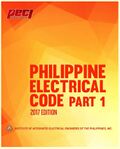Template:PEC Editions: Difference between revisions
| (5 intermediate revisions by the same user not shown) | |||
| Line 1: | Line 1: | ||
== PEC | == 1.0 Philippine Electrical Code (PEC) == | ||
<div class="container"> | <div class="container"> | ||
<div class="row"> | <div class="row"> | ||
| Line 19: | Line 19: | ||
</div> | </div> | ||
<div class="row"> | <div class="row"> | ||
'''Note''': To enable better understanding on the mark-ups used in this '''Design Guide''', it is recommended that this part of the [[:Category:{{PEC}} | {{PEC}}]] will be read first prior to going further into the {{PEC}} '''Design Guide'''. | |||
</div> | |||
<div class="row"> | |||
The Philippine Electrical Code (PEC) is a set of standards and regulations that govern the safe and proper installation, operation, and maintenance of electrical systems in the Philippines. It provides guidelines for electrical design, wiring, equipment selection, grounding, protection, and other related aspects to ensure electrical safety and efficiency. | |||
The PEC is primarily based on the National Electrical Code (NEC) of the United States but incorporates modifications and adaptations to suit the local conditions, practices, and regulations in the Philippines. It is published and updated by the Institute of Integrated Electrical Engineers of the Philippines (IIEE) in collaboration with the Board of Electrical Engineering (BEE) and the Philippine Association of Certified Public Accountants (PACPA). | |||
The PEC covers various aspects of electrical installations, including but not limited to: | |||
'''General Requirements''': This section outlines the scope and application of the code, definitions of terms, and general principles for electrical installations. | |||
'''Wiring Methods and Materials''': It provides guidelines for the selection and installation of wiring systems, cable types, conductors, raceways, and wiring techniques. | |||
'''Grounding and Bonding''': This section covers the proper grounding and bonding of electrical systems, including grounding electrodes, grounding conductors, equipment grounding, and bonding requirements. | |||
'''Overcurrent Protection''': It specifies the requirements for protective devices such as circuit breakers and fuses to prevent overcurrent conditions and ensure the safety of electrical installations. | |||
'''Electrical Equipment and Devices''': This section provides guidelines for the selection, installation, and use of electrical equipment, including switches, receptacles, lighting fixtures, and appliances. | |||
'''Special Occupancies and Locations''': It covers specific requirements for electrical installations in hazardous locations, swimming pools, medical facilities, marinas, agricultural buildings, and other special occupancies. | |||
'''Electrical Services and Systems''': This section deals with electrical service entrances, distribution systems, metering, grounding of service equipment, and requirements for electrical service providers. | |||
The PEC is regularly updated to incorporate technological advancements, industry best practices, and changes in local regulations. It is essential for electrical engineers, electricians, contractors, and other professionals involved in electrical installations to adhere to the code to ensure electrical safety and compliance with the law. It is also a valuable reference for building owners, facility managers, and individuals seeking knowledge about electrical systems. | |||
</div> | </div> | ||
</div> | </div> | ||
Latest revision as of 03:54, 25 October 2024
1.0 Philippine Electrical Code (PEC)
Note: To enable better understanding on the mark-ups used in this Design Guide, it is recommended that this part of the Philippine Electrical Code will be read first prior to going further into the Philippine Electrical Code Design Guide.
The Philippine Electrical Code (PEC) is a set of standards and regulations that govern the safe and proper installation, operation, and maintenance of electrical systems in the Philippines. It provides guidelines for electrical design, wiring, equipment selection, grounding, protection, and other related aspects to ensure electrical safety and efficiency.
The PEC is primarily based on the National Electrical Code (NEC) of the United States but incorporates modifications and adaptations to suit the local conditions, practices, and regulations in the Philippines. It is published and updated by the Institute of Integrated Electrical Engineers of the Philippines (IIEE) in collaboration with the Board of Electrical Engineering (BEE) and the Philippine Association of Certified Public Accountants (PACPA).
The PEC covers various aspects of electrical installations, including but not limited to:
General Requirements: This section outlines the scope and application of the code, definitions of terms, and general principles for electrical installations.
Wiring Methods and Materials: It provides guidelines for the selection and installation of wiring systems, cable types, conductors, raceways, and wiring techniques.
Grounding and Bonding: This section covers the proper grounding and bonding of electrical systems, including grounding electrodes, grounding conductors, equipment grounding, and bonding requirements.
Overcurrent Protection: It specifies the requirements for protective devices such as circuit breakers and fuses to prevent overcurrent conditions and ensure the safety of electrical installations.
Electrical Equipment and Devices: This section provides guidelines for the selection, installation, and use of electrical equipment, including switches, receptacles, lighting fixtures, and appliances.
Special Occupancies and Locations: It covers specific requirements for electrical installations in hazardous locations, swimming pools, medical facilities, marinas, agricultural buildings, and other special occupancies.
Electrical Services and Systems: This section deals with electrical service entrances, distribution systems, metering, grounding of service equipment, and requirements for electrical service providers.
The PEC is regularly updated to incorporate technological advancements, industry best practices, and changes in local regulations. It is essential for electrical engineers, electricians, contractors, and other professionals involved in electrical installations to adhere to the code to ensure electrical safety and compliance with the law. It is also a valuable reference for building owners, facility managers, and individuals seeking knowledge about electrical systems.

